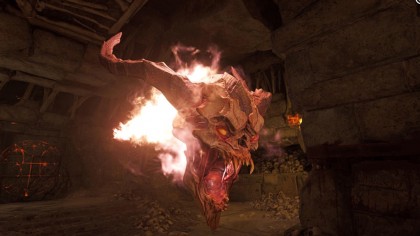Doom review
A potent cocktail of retro and modern
Call of Doomy
Doom's single player manages to finely balance elements of both modern and retro game design. Doom's multiplayer meanwhile mashes the two together into an experience that ends up feeling forgettable and bland.
You've got a full raft of modes, from standard team Deathmatch and King of the Hill style modes to modes such as 'Soul Harvest' which requires players to collect the souls of their enemies to get points rather than just killing them.

It's nice to play a big-budget arena shooter in 2016, but the combination of these traditional elements with more modern power-ups and skill trees never quite sits well together. There are certain abilities you'll have to unlock through play, but others that you need to find in the map, and the result is a multiplayer experience that feels like it lacks any real identity of its own.
SnapMap
It's in Doom's level editor, SnapMap, where the game is likely to find its longevity. SnapMap is much more than a taped-on afterthought; it's a fully fleshed out appendage that's easy to use, yet offers surprising granularity.
The SnapMap editor can be used to create maps for a range of competitive modes, co-op, or single player campaign missions.
Sticking various bits of room together is as simple as playing with Lego, before you zoom in to fill each with props, weapons, enemies and spawn points. Things start getting more complex when you start playing with logic chains, but the game's tutorials are there to guide you should you need them. You'll pick it up quick enough.
Setting up logic commands will mean you choose when certain events happen - for example, making certain enemies spawn when a player performs a specific action. In one Capture the Flag map, I created a simple logic chain that triggered several barrels around the map to explode when one team scored - just to up the ante. A further set of commands could then cause fresh barrels to appear for the next round.
Sign up for breaking news, reviews, opinion, top tech deals, and more.

Best of all, you can share your masterpieces with the world for other players to enjoy. There are plenty of creations already out there, from remakes of the original Doom's maps to a disco map that plays the Funky Town tune as deadly lasers dance around the room. Just because.
One map I tried was single corridor lined with explosives, and the goal was to run to the end without being caught in the fire. As you can probably tell, SnapMap opens up the game to a lot of possibilities. There aren't many good ones yet, but I'm sure it won't take long for some of the more interesting and clever ideas to bubble up to the surface.
Verdict: Play It Now
Id Software's Doom is a remarkable achievement that manages to remind us what was so brilliant about the original games while updating them with select elements from the last twenty years.
It remains to be seen how big of an impact SnapMap will end up having, but the foundation is definitely there for people to create some very interesting levels. The original Doom games have spawned a modding community that's still active today, and it will be interesting to see if 2016's Doom can ignite that sort of creativity in the long term.
But this review is about the Doom package as it exists today, and the strength of the single player experience alone makes the game worthy of your time. The action is fast-paced, diverse, and balanced in such a way that you're constantly getting into the meat of the action rather than holding back and playing it safe.
It felt for the longest time that first-person shooters had left games like the original Doom in the past, but 2016's Doom proves that this style of shooter can still be a great deal of fun without feeling old-fashioned.
The multiplayer may not be a massive selling point, and the single player could be criticised for being a bit repetitive, but when the core shooting is as fun as it is, it's hard not to play Doom with a big smile on your face.
This game was reviewed on PS4.
Techradar's review system scores games as 'Don't Play It', 'Play It' and 'Play It Now', the last of which is the highest score we can give. A 'Play It' score suggests a solid game with some flaws, but the written review will reveal the exact justifications.

Jon Porter is the ex-Home Technology Writer for TechRadar. He has also previously written for Practical Photoshop, Trusted Reviews, Inside Higher Ed, Al Bawaba, Gizmodo UK, Genetic Literacy Project, Via Satellite, Real Homes and Plant Services Magazine, and you can now find him writing for The Verge.